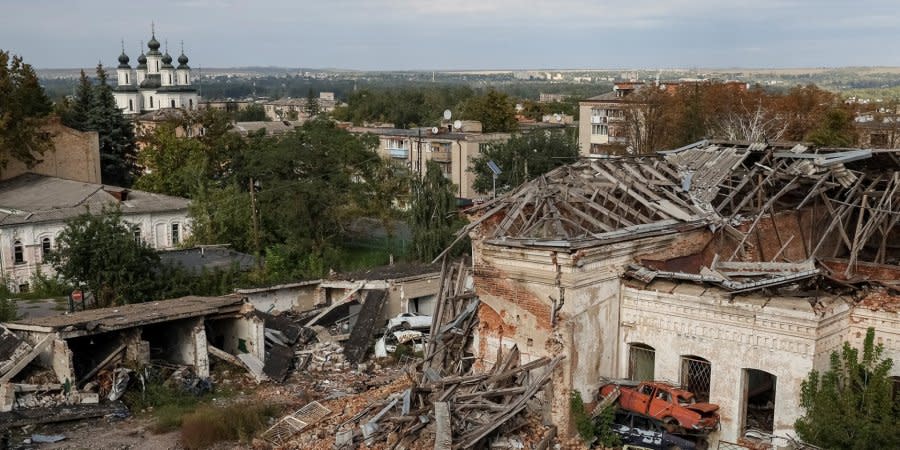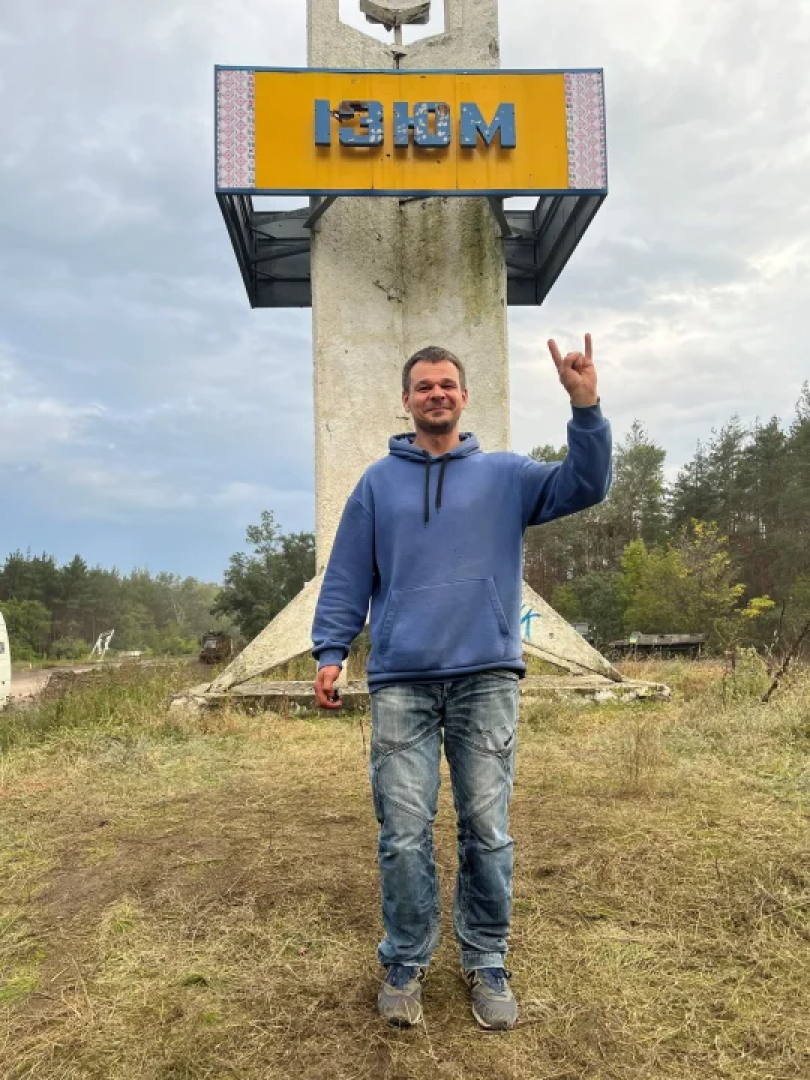Volunteer explains what life under occupation was like in Izyum

During the occupation, more than half of the population of the 46,000-strong town managed to leave, while others were taken hostage by invading Russian forces. After the invaders fled, at least 445 graves with the bodies of military servicemen and civilians, including children, were found in a nearby forest belt. Currently, almost 350 bodies — all bearing sign of a violent death — have already been exhumed. These are victims of shelling, torture, and abuse. According to law enforcement officers, the death toll could be much higher.
Meanwhile, those residents who were lucky enough to survive are now learning to live anew in their free, but completely destroyed city, without water, gas, or power. Maxim Krakovsky, a Kyiv resident and a volunteer with the NGO “Enjoying Life”, was one of the first to arrive in liberated Izyum with food and other necessities.
Krakovsky spoke to NV about what he saw and heard in Izyum. The following is a transcript of his story, edited for readability and clarity.

The first thing you notice in liberated Izyum is a very big difference in the moods of the population. In Kyiv and Chernihiv oblasts that we visited in the first days, people after the liberation didn’t fully understand that the war had begun. Everything took them by surprise and they just found themselves in a whirlpool of events, so they were confused and scared. In Izyum, people lived half a year under occupation, had seen enough of everything, and seemed to have become accustomed to the war.
The landscape of the city, on the contrary, is very similar to the Kyiv area and the Chernihiv area after the liberation: gas stations and shops were destroyed, buildings were destroyed, houses without roofs and windows, and sometimes you find completely unaffected neighborhoods. Between all this, people go about their usual business, cut the grass and trim the trees.
In early March, water, electricity, and communications disappeared in Izyum. And the only place where you could catch a Ukrainian mobile signal was Mount Kremenets, the highest point in Kharkiv Oblast. So, having climbed on it, the residents of the city learned how the landscape around them had changed, where new destruction had appeared, where the attacks were coming from and from which side they were being shelled. Later, a generator was installed in the district administration, so in the morning the locals handed over all their gadgets for charging and took them back in the evening to read or watch a movie.
Food was cooked on a fire in the yard. The situation with food was okayish - some markets were open, and someone brought stuff from the territory of Russia. Also the invaders gave out their so-called humanitarian aid - a can of stew once every two weeks.
Later, the shops started to open, but with a rule: price tags should be in hryvnias and rubles, and if they were only in hryvnias, the store would get robbed.
Pensions were paid to the locals in rubles, as were the salaries for the city maintenance crews. In cash of course. So, obviously, the first question from these people is: “What is the exchange rate of the ruble against the hryvnia in Ukraine now?”
At the beginning (of the occupation), locals were not too limited in their movements around the city. But before the Ukrainian army went on the offensive, the Russians completely locked people up in their own homes, and didn’t let them out for several days. It was hardest for the residents of high-rise buildings, because they were shelled more often, and many had to live in half destroyed apartments. And if the irregular electricity supply was back in some places, the water supply was never resumed. Unlike Kherson and Zaporizhzhia oblasts, the Russians didn’t invest in communications here at all.
What surprised me is that there are a lot of young people and children under 14 left in the town. This is such a standard story: someone thought that they could leave by car at any moment, someone had nowhere to go, and someone didn’t want to leave their garden. Now they are all in good spirits and, to my surprise, they are very friendly and open. Everyone comes up to share their happiness, they want to hear the news, they ask how it was in other parts of Ukraine all this time, they talk about themselves. These stories are painfully similar: about how one of the relatives was killed and how the rest lives on, because they have to. Shelling often caught Izyum residents while they were in their gardens. The younger ones immediately ran for cover, while the older ones simply didn’t have the time - so they were killed right there with a shovel or a trimmer in their hands.
Most of all, I was struck by the stories about the "LPR" who held the city at first. According to the locals, they hated Ukraine and Ukrainians so much that living with them was the worst thing. While the stories, they say, were different, the most common one is that the “LPR” would drive up to a house with two Ural trucks, lock people in the barn, and silently take everything out. Then they would go to the market and sell it.
The Russians had some kind of long-standing conflict with the “LPR”, so sometimes they put them in their place, but the Russians themselves profited from this too. A 65-year-old man said that when his car was taken away, he had to go to the Russian commandant and negotiate for the money to get his car back. Or here is another story, from a woman whose son was a participant in the ATO (Anti-Terrorist Operation in Donbass of 2014). Usually, the invaders used the following scheme - as soon as they occupy a settlement, they first ask where the ATO servicemen live. So, she says, her son was taken away, and she needed to pay a “crazy” amount to release him – $400, about an average pre-war month’s salary in Kyiv. For Izyum, this is a large amount. After that, the woman hid her son in the basement until the end of the occupation, supplying him with food and water.
It wasn't the worst idea. In occupied Izyum, the practice of kidnapping activists and people with pro-Ukrainian views was widespread. It could have happened anywhere. Russians can check people’s phones on the street and if there is something on it they didn’t like, that person disappears. Or one of the neighbors “snitches” and then a group of Russians purposefully arrives at your door. Some of these people weren’t found, some returned home as a broken person, some hung themselves after suffering torture, some stopped talking altogether.
Most often, when the locals come to us, they begin to cry and describe everything simply in one word - “horror”. For example, one afternoon, the “LPR” militants got drunk, turned the “Grad” multiple launch rocket system in the wrong direction and fired into the square, where people were waiting in line for a car with bread. Fifteen people were killed with one shot. Locals also spoke about how they had to pull people out of burning high-rise buildings with their own hands after being hit by a shell, because no one else cared ton do it. They were forbidden to appear at the cemetery for unknown reasons, so many buried the dead in the forest or in courtyards.
In general, the concept of the value of life is deformed among people who have lived for such a long time under occupation. It is greatly devalued. For example, here is the story of a young guy: “You are walking down the street, and at the other end, drunk “LPR” guys are arguing over who respects whom for what. One of them raises a Kalashnikov at you and starts aiming, while you calmly jump into the grass, because that’s your life.”
The same goes for shelling: people told me how they continued to play chess while everything outside the windows hummed and burned. They had already given up on themselves, no one was moving anywhere, they were just continuing to survive somehow.
Read the original article on The New Voice of Ukraine

